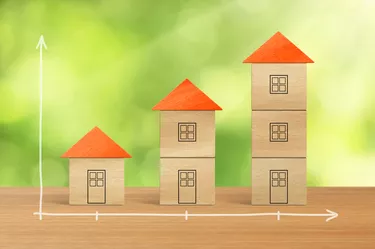
Interest rates on standard mortgages do not compound monthly, because interest on such loans does not compound at all. A standard mortgage charges simple interest on a monthly basis. This means that each month, you pay all of the interest due, so there's no unpaid interest to compound. This is good for borrowers, as it means each payment brings them closer to owning their home outright. That said, there's one type of mortgage that allows for compounding -- the so-called negative amortization loan.
How Compounding Works
Video of the Day
Compounding refers to taking the interest that has accumulated on a loan and adding it to the loan balance, so that you end up paying interest on interest. For example, say you borrow $100 for a year at 6 percent annual interest, compounded monthly. The 6 percent annual rate translates to 0.5 percent a month -- 6 percent divided by 12. After the first month, you'll be charged 50 cents interest-- 0.5 percent of $100. That 50 cents is added to your loan balance, making it $100.50. The next month, you'll be charged 50.25 cents of interest-- 0.5 percent of $100.50. In other words, you are now being charged interest on the previous month's interest. That's how compounding works. Credit card balances accrue compound interest, and money you deposit in interest-bearing accounts earns compound interest. Standard mortgages, however, do not compound.
Video of the Day
Mortgages and Simple Interest
Determining Your Payment
Mortgage lenders use an amortization formula to set your monthly payment based on three factors:
- The amount of money you borrow, the principal.
- The length of the loan term, such as 15 years or 30 years.
- The interest rate on the loan.
Each monthly payment on your mortgage is enough to cover all of the outstanding interest, as well as a portion of the principal. The act of amortizing loan interest over the life of your loan divides the interest out to each principle payment. Since there is no unpaid interest after each monthly payment, there is no compounding. For example, say you take out a $100,000 mortgage for 30 years at 6 percent annual interest, charged at 0.5 percent per month. The amortization formula would give you a monthly principle plus interest payment of $599.55.
Breaking Down the Payment
When your first payment comes due, you owe the full $100,000, so you will be charged $500 worth of interest, or 0.5 percent of $100,000. The remainder of your first payment -- $99.55 -- goes toward reducing your principal. Your loan balance drops to $99,900.45. Again, you have no unpaid interest, so there is no compounding.
Your second payment will include 0.5 percent interest on $99,900.45, which is $499.50. The remainder of your monthly payment -- 100.05 -- goes toward reducing principal. With each succeeding payment, the amount of interest you pay goes down, while the amount of principal you repay goes up. This continues until the very last payment, which will be made up of just $2.98 of interest and $596.57 of principal.
The One Exception
The only kind of mortgage that could involve compounding is one that allows negative amortization. This is a nonstandard or "exotic" mortgage in which the lender allows, but doesn't require, you to pay less than the accrued interest on the loan each month for the first year or two of the loan. In such cases, the unpaid portion of the interest gets added back into the loan balance, with the result being compound interest.
How Neg-Am Mortgages Work
Say you have a 30-year, $100,000, 6 percent loan like the one described earlier, but your lender says you can make a minimum payment of just $400 a month. At the time of your first payment, you owe $500 in interest. If you make the minimum payment, there will be $100 in unpaid interest, which compounds, raising your balance to $100,100. The next month, you owe $500.50 in interest. You pay $400 again, and the leftover $100.50 goes on your balance, and so on. In a negative amortization loan, the interest compounds monthly.
At some point, a "neg-am" mortgage converts to a fully amortizing loan -- meaning your payments reset so that they'll cover both principal and interest, just like a regular mortgage. If the loan in the example converted to fully amortizing after one year, your balance would be about $101,128. Over the remaining 29 years of the loan, your payment would be about $614. If the conversion came after two years, your balance would be $102,431, and your payment would be about $630.
Payment Shock
When neg-am mortgages convert to fully amortizing, the monthly payment usually goes up substantially. In the example, the increase was well over 50 percent. Some of this is due to the effects of compound interest, but the biggest factor in the increase is simply that the previous payment was artificially low -- not even enough to cover the interest. Mortgage specialists refer to this sudden increase as payment shock, and it can trigger default if borrowers don't have the money. The longer the neg-am period at the beginning of the loan, and the bigger the shortfall between the initial monthly payment and the fully amortizing payment amount, the bigger the shock will be.